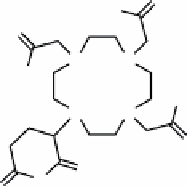Chemistry Reference
In-Depth Information
In vivo
studies showed that particles administered intravenously could be directed to a tumour using an external magnet.
The UCL increased over time and the MR image of the tumour darkened. Biodistribution showed the particles could be
found (detection of Y
3+
) in the lung, spleen, and liver for up to 40 days after injection. However, histological analysis showed
that the particles did not appear to induce any toxic effects, damage, or inflammation in these organs.
The particles were used as a photothermal therapeutic. Several control systems were studied to observe the effect of
magnetic targeting and photothermal therapy (PTT). The systems studied were untreated, laser only, NPs + magnet,
NPs + laser, NPs + magnet + laser. Tumour volume increased in all cases except the last, which were tumour-free after the
treatment. Further, the mice survived over 40 days in contrast to the mice from the control groups which lived 14-18 days.
Future work will involve reducing the nanoparticle size, varying the surface coating to reduce the circulation time and RES
retention.
16.6
pet-Spect-ct-MrI
16.6.1
biodistribution
A top-down approach was used to generate silica-based particles for combined fluorescence/MR/SPECT/CT [84]. First,
Gd
2
O
3
nanoparticles were coated with SiO
2
and Cy5.5 was encapsulated during the formation of the SiO
2
layer. DOTA-GA
anhydride (1,4,7,10-tetraazacyclododecane-1-glutaric anhydride-4,7,10-triacetic acid; CheMatech, Figure 16.23) was added,
which effectively dissolves the Gd
2
O
3
core and provides DOTA-chelated Gd ions on the surface of a collapsed polysiloxane
platform. The result is a ratio of 10 DOTA:7Gd:27 Si. Free DOTA groups were used to chelate
111
In from
111
InCl
3
solutions.
The size of the particles was determined to be approximately 3 nm.
Biodistribution studies in mice showed accumulation in the kidney and bladder, but not lungs or liver, and indicate a renal
clearance pathway. The circulation lifetimes were characterised by a multi-exponential fit that indicated the presence of a
slow-clearing component. This study illustrates the existence of an intermediate size range that is too large for efficient renal
clearance yet too small for hepatic clearance.
A similar system for fluorescence/MR/SPECT/CT was prepared fromGd
2
O
3
particles that were synthesised according to
a modified polyol method [85]. TEOS/APTES were used to modify the surface via controlled hydrolysis and condensation.
Cy5-NHS and DTPA-bisanhydride were attached to the surface amine groups from the APTES (Scheme 16.11).
111
In was
chelated by coordinating to the surface DTPA.
Biodistribution showed renal excretion and no uptake by the RES. Evaluation of
111
In levels in brain, liver, heart, lung, mus-
cles, bone, skin, spleen, and kidney was determined at 2 h, and at 1, 3, 10, and 18 days. By far the majority of the radioactive
111
In was detected in the kidneys at all time points. Similar results were obtained using SPECT/CT, MR, and optical imaging.
O
O
O
NN
O
O
N
N
O
O
O
O
fIGure 16.23
Structure of 1,4,7,10-tetraazacyclododecane-1-glutaric anhydride-4,7,10-triacetic acid.
O
O
O
OH
O
O
O
-
N
O
O
OO
O
N
O
N
O
O
111
InCl
3
N
H
2
NR
HO
O
N
O
NH
N
HN
O
H
2
O
N
N
N
R
R
OH
O
O
O
OH
=
111
In
OH
ScheMe 16.11
Reaction of DTPA bisanhydride followed by metallation with
111
In. In this case, the amine is on the nanoparticle surface.


